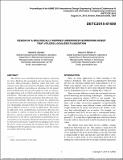| dc.contributor.author | Dorsch, Daniel S. | |
| dc.contributor.author | Winter, Amos G. | |
| dc.date.accessioned | 2017-05-22T17:07:56Z | |
| dc.date.available | 2017-05-22T17:07:56Z | |
| dc.date.issued | 2015-08 | |
| dc.identifier.isbn | 978-0-7918-5712-0 | |
| dc.identifier.uri | http://hdl.handle.net/1721.1/109258 | |
| dc.description.abstract | The Atlantic razor clam (Ensis directus) digs by contracting its valves, fluidizing the surrounding soil and reducing burrowing drag. Moving through a fluidized, rather than static, soil requires energy that scales linearly with depth, rather than depth squared. In addition to providing an advantage for the animal, localized fluidization may provide significant value to engineering applications such as vehicle anchoring and underwater pipe installation. This paper presents the design of a self-actuated, radially expanding burrowing mechanism that utilizes E. directus burrowing methods. The device is sized to be a platform for an anchoring system for autonomous underwater vehicles. Scaling relationships presented allow for design of burrowing systems of different sizes for a variety of applications. The motion to sufficiently create soil fluidization is presented. Max force for the actuator to contract is based on force to pump fluid out of the device, and max expansion force is determined by the soil. Friction force in the device and potential considerations for increased force are presented. Data from laboratory tests are used to characterize how power is split between pumping water out of the device versus accelerating the mechanism itself. These relationships provide the optimal sizing and power needs for various size subsea burrowing systems. | en_US |
| dc.description.sponsorship | National Science Foundation (U.S.) (Graduate Research Fellowship under Grant No. 1122374) | en_US |
| dc.description.sponsorship | Bluefin Robotics | en_US |
| dc.language.iso | en_US | |
| dc.publisher | American Society of Mechanical Engineers | en_US |
| dc.relation.isversionof | http://dx.doi.org/10.1115/DETC2015-47459 | en_US |
| dc.rights | Article is made available in accordance with the publisher's policy and may be subject to US copyright law. Please refer to the publisher's site for terms of use. | en_US |
| dc.source | American Society of Mechanical Engineers (ASME) | en_US |
| dc.title | Design of a Biologically Inspired Underwater Burrowing Robot That Utilizes Localized Fluidization | en_US |
| dc.type | Article | en_US |
| dc.identifier.citation | Dorsch, Daniel S., and Amos G. Winter. “Design of a Biologically Inspired Underwater Burrowing Robot That Utilizes Localized Fluidization.” Volume 5A: 39th Mechanisms and Robotics Conference (August 2, 2015). | en_US |
| dc.contributor.department | Massachusetts Institute of Technology. Global Engineering and Research Laboratory | en_US |
| dc.contributor.department | MIT-SUTD Collaboration Office | en_US |
| dc.contributor.department | Massachusetts Institute of Technology. Department of Mechanical Engineering | en_US |
| dc.contributor.mitauthor | Dorsch, Daniel S. | |
| dc.contributor.mitauthor | Winter, Amos G. | |
| dc.relation.journal | Volume 5A: 39th Mechanisms and Robotics Conference | en_US |
| dc.eprint.version | Final published version | en_US |
| dc.type.uri | http://purl.org/eprint/type/ConferencePaper | en_US |
| eprint.status | http://purl.org/eprint/status/NonPeerReviewed | en_US |
| dspace.orderedauthors | Dorsch, Daniel S.; Winter, Amos G. | en_US |
| dspace.embargo.terms | N | en_US |
| dc.identifier.orcid | https://orcid.org/0000-0001-9233-2245 | |
| dc.identifier.orcid | https://orcid.org/0000-0002-4151-0889 | |
| mit.license | PUBLISHER_POLICY | en_US |
| mit.metadata.status | Complete | |
